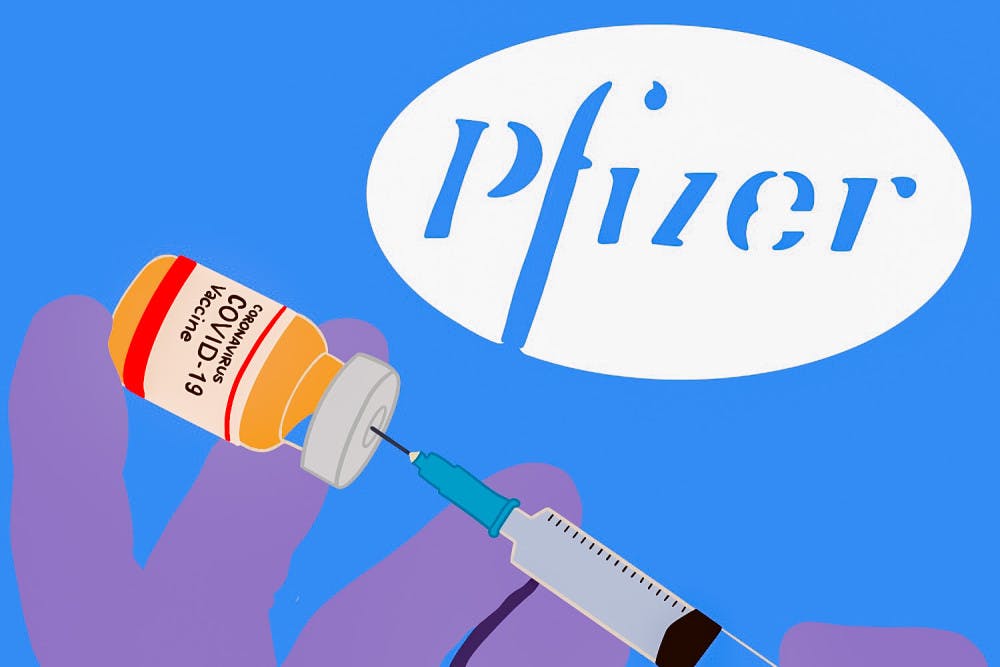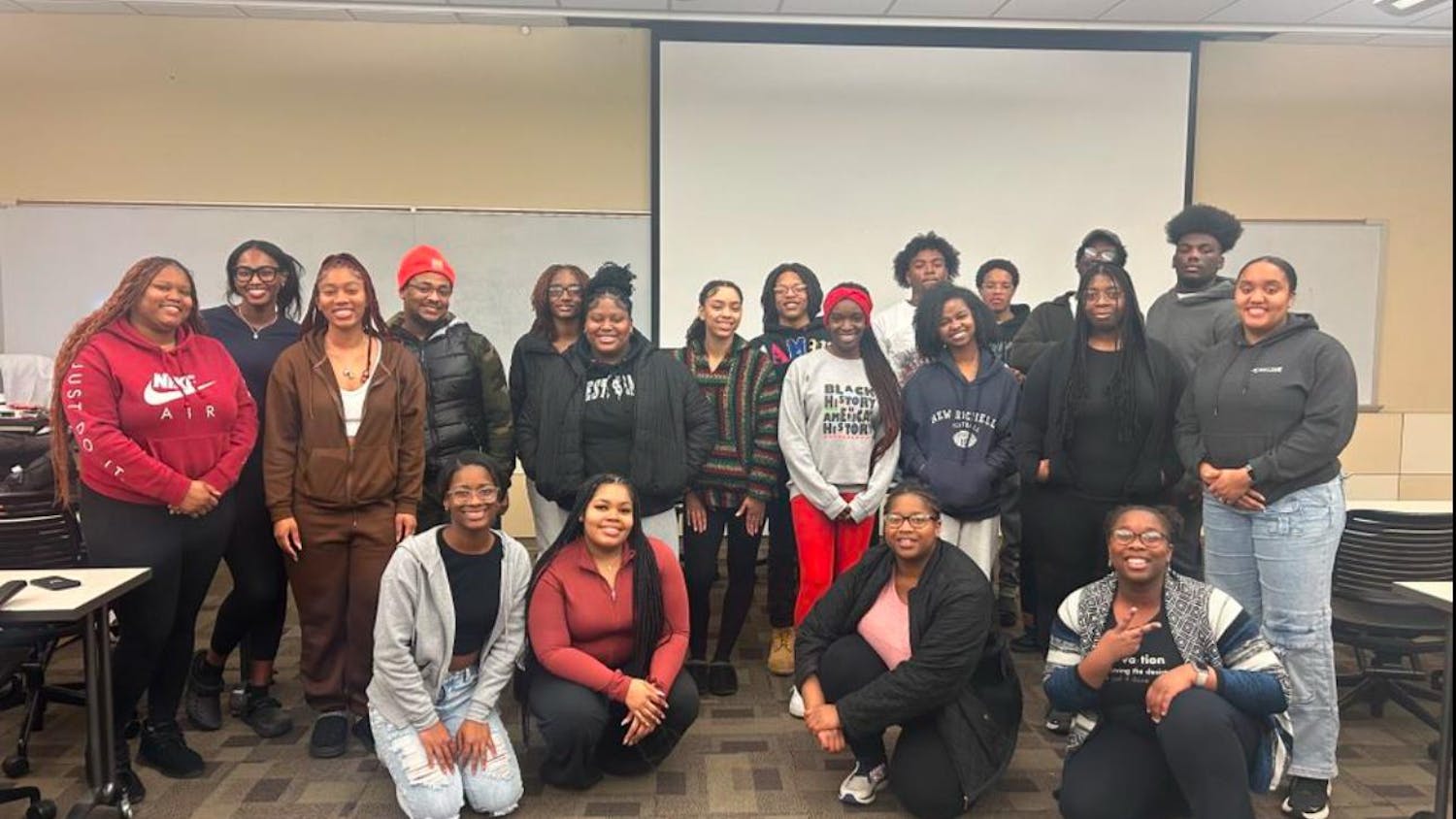Pfizer COVID Vaccine | Illustration by Kayli Thompson | The Wright State Guardian
U.S. companies Pfizer and Moderna are making history with their coronavirus vaccines, not just due to how quickly they were made, but also because of what is inside of them.
In clinical trials, it was announced that Pfizer and BioNTech’s vaccine was 95% effective with a little over 43,000 volunteers, and Moderna’s vaccine was announced to be 94.5% effective with around 30,000 volunteers.
If both of these vaccines are approved by the FDA, they will be the first vaccines in history to use mRNA. After approval, the U.S. Government plans to provide doses for 20 million people by the end of the year.
Distribution
There is no use to these vaccines if they can not be distributed. Making sure that as many people as possible are vaccinated is where Moderna’s vaccine has the advantage over Pfizer.
In order for Pfizer to take its vaccine around the world, it needs to be stored at -94 degrees Fahrenheit, making the drug incredibly impractical to ship.
The company has created special containers that can store 5,000 doses of the drug, but if in a regular freezer, the drug will only stay viable for 5 days.

Angela Hwang, Pfizer Bio Group President, hopes that their program can serve as a model for future vaccination.
“This pilot program and our collaboration with U.S. and state officials will help us prepare for broader vaccine deployment in the near future,” she said. “We are hopeful that results from this vaccine delivery pilot will serve as the model for other U.S. states and international governments."
Luckily, Moderna’s vaccine is a lot less problematic. The drug can survive at refrigerator temperature for up to 30 days, and can even be made viable for up to 6 months if stored at a cold enough temperature.
Juan Andres, Chief Technical Operations and Quality Officer at Moderna, hopes that Moderna’s candidate will be able to begin vaccination across the United States soon.
“The ability to store our vaccine... is an important development and would enable simpler distribution and more flexibility to facilitate wider-scale vaccination in the United States and other parts of the world.” he said.
Going into 2021, vaccines will first be administered to priority targets, mainly health professionals, government officials and people most at risk to death from the coronavirus. After these people are vaccinated, it will be made available to the general public.
What’s Inside?
There has been much speculation regarding both the Pfizer vaccine’s and Moderna vaccine’s safety, due to how quickly they were made, and the mRNA inside of them.
Dawn Wooley, a Professor at the Boonshoft School of Medicine, gave an idea on how mRNA vaccines work.
“The mRNA in these vaccines is a piece of genetic information that codes for the infamous "spike" proteins of SARS-CoV-2,” she said. “When the mRNA is injected into a person, the mRNA is translated into the spike protein. A person's immune system will then react against the spike protein in such a way as to kill the virus when they are exposed to it.”
The vaccine contains a piece of the inactive virus, so that the body can better prepare against it.
Because there is a piece of the virus inside of the vaccine, there are some critics to its safety. However, Wooley stresses that the virus is as safe as possible.
“These vaccines were developed very quickly because the companies used existing vaccine platforms that were being developed against cancer and they steered them towards COVID-19,” Wooley commented. “The vaccines are showing excellent efficacy and short-term safety profiles. My only concern is long-term follow-up… Some potential adverse effects may take years to show up, for example auto-immune reactions.”
Skepticism for vaccines has been around for decades, but Dr. Wooley is optimistic that these vaccines and the coronavirus pandemic can help change perceptions.
“There has been mistrust in vaccines long before COVID-19, ever since the MMR vaccine was linked to autism in 1998… So, skepticism about vaccines is nothing new. It is possible the COVID-19 might show people how important vaccines are and help to turn around this mistrust of vaccines,” said Wooley.
What do I do until I get a vaccine?
Especially with counties around Dayton being in “red zones” for coronavirus cases and with winter approaching, it is more important than ever to stay vigilant.
“People need to heed the recommendations of the medical professionals and take personal responsibility to protect themselves and the people around them,” said Wooley. “Use common sense.”
Since respiratory viruses spread more quickly at this time of year, it is important that everyone follows social guidelines put forward by the state of Ohio.
“Colder temperatures also suppress the immune system leaving people more vulnerable to infection,” said Wooley. “These weather conditions drive people indoors where the transmission can occur. People need to be extra careful at this time of year as the influenza virus also hits at this time. We are entering the most dangerous time of the year for respiratory viruses.”












